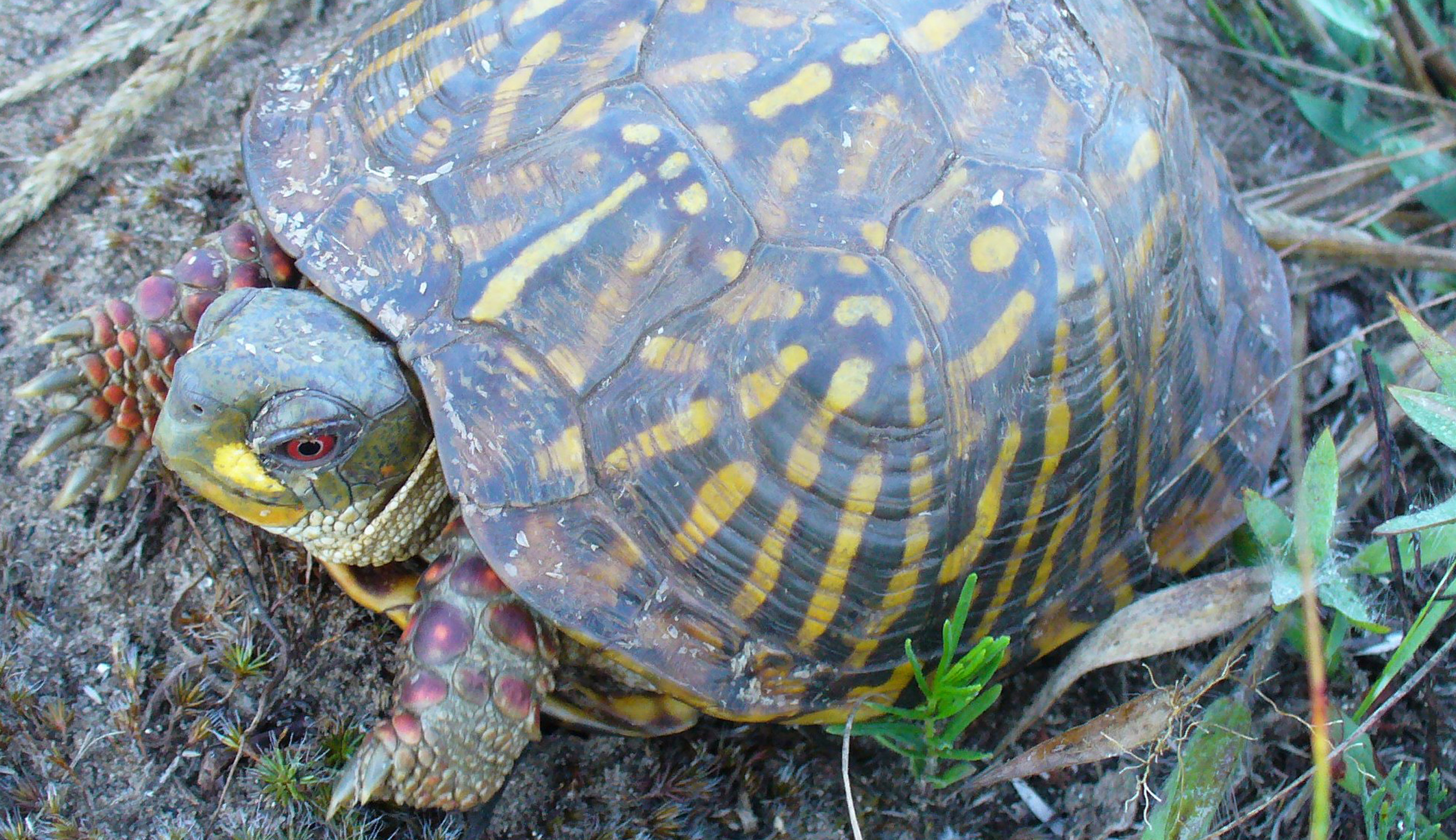The Ornate Box Turtle was listed as an endangered species in October, 1972. Since its listing, the Wisconsin Department of Natural Resources (WDNR) and The Nature Conservancy began to acquire lands that were suitable for this species, or that had the potential to be restored.
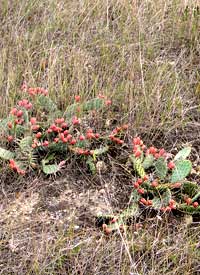
This turtle has a unique and highly specialized habitat requirement that allows the turtle to survive at this latitude. That habitat is called dry sand prairie, the majority of which is associated with the Lower Wisconsin River floodplain and adjacent southerly exposed bluffs. Here deep sand deposits have created the opportunity for this terrestrial (land dwelling) turtle to overwinter successfully since they must burrow deep enough in the sand to avoid freezing in winter. The turtle is unable to dig effectively in denser soils, which has significantly restricted its range in Wisconsin to these sandy habitats. Colder winters in central and northern Wisconsin have limited it from ranging further north, despite the availability of sandy soils. Dry sand prairie is very well drained and supports one of Wisconsin’s two cactus species, the Prickly Pear Cactus Opuntia sp.).
In the early decades of Wisconsin’s history, settlers and subsequent farmers attempted to grow crops on these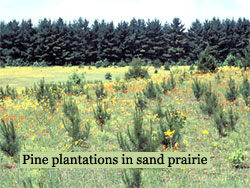 prairies, but in most years the crops failed due to the dry conditions. Many of these sites had been disturbed but began to revert to sand prairie when farming efforts failed. Many referred to this habitat at that time as “wasteland”, since it had no agricultural value. However, in the 1950s the practice of planting pine plantations started to occur on this “wasteland” habitat and the land increased in economic value. In 1948, center-pivot irrigation was invented and its use started to become more widespread in Wisconsin during the 1950s and 1960s. Much of the remaining dry prairie was rapidly converted to productive agricultural land for corn, potatoes and soybeans. By the mid-1960s, these changes had resulted in nearly complete conversion of the remaining dry sand prairie to productive agriculture and pine plantations. It wasn’t until much of the land conversion had taken place that early conservationists noted the decline of species that were highly dependent on this unique habitat. Since that time, efforts to purchase and restore these rare and valuable habitats has occurred, and along with it, the preservation of many species that would have been lost without these efforts.
prairies, but in most years the crops failed due to the dry conditions. Many of these sites had been disturbed but began to revert to sand prairie when farming efforts failed. Many referred to this habitat at that time as “wasteland”, since it had no agricultural value. However, in the 1950s the practice of planting pine plantations started to occur on this “wasteland” habitat and the land increased in economic value. In 1948, center-pivot irrigation was invented and its use started to become more widespread in Wisconsin during the 1950s and 1960s. Much of the remaining dry prairie was rapidly converted to productive agricultural land for corn, potatoes and soybeans. By the mid-1960s, these changes had resulted in nearly complete conversion of the remaining dry sand prairie to productive agriculture and pine plantations. It wasn’t until much of the land conversion had taken place that early conservationists noted the decline of species that were highly dependent on this unique habitat. Since that time, efforts to purchase and restore these rare and valuable habitats has occurred, and along with it, the preservation of many species that would have been lost without these efforts.
The first Ornate Box Turtle conservation program was developed and initiated by the WDNR’s Bureau of Endangered Resources in 1992. This “recovery” effort had two primary components:
- Preserve the genetic diversity that was represented by the various small remnant populations of Ornate Box Turtles in the state.
- Develop and implement methods to rebuild populations. These methods involved two strategies, both of which were untested for this species. One strategy was translocation (moving turtles from one location to another) and the other was headstarting (the captive hatching and rearing of turtles).
Translocation – Within State
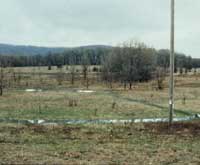
The preservation of genetics proved to be a difficult challenge as most of the remnant populations occurred on small patches of dry prairie, primarily on private lands. A landowner contact program was initiated in 1992 to determine where Ornate Box Turtles were still persisting and evaluate the habitats it was using. This work was limited to habitats where landowners were willing to allow us on their properties. In most cases, these prairie remnants were quite small (several acres) and did not have the potential to be expanded because of competing land use practices. It became apparent that the only way to salvage the genetics that each of these small populations contained was to translocate the turtles to a larger parcel of dry prairie. A dry prairie site that no longer supported Ornate Box Turtles was selected in southwestern (SW) Wisconsin to be the recipient home for the translocated turtles. In order to maintain them on the recipient site, an enclosure was constructed that was large enough to contain the various microhabitats that the species required. We then began the translocation efforts.
During the summer of 1992, 20 adult and sub-adult Ornate Box Turtles were moved to the enclosure from a handful of private landowner 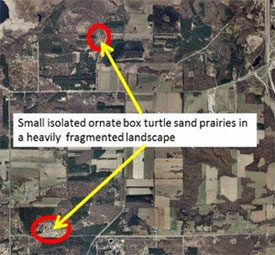 sites. These turtles were held in the enclosure for one season and overwintered on the site. In 1993, ten of these turtles, five males and five females, were fitted with radio transmitters. They were released outside the enclosure to determine what they would do, focusing on whether they would stay on site or attempt to return to their natal site. Fifty percent of the turtles stayed on site for the summer but the other 50% left the site in a variety of directions. These five that attempted to stray from the site were returned to the enclosure where they were maintained for another year. After their second year of being held in the enclosure, they were again fitted with transmitters and released outside the enclosure. That year all of the turtles remained on site. The following year we began to release some of the other enclosed turtles at the site in order for them to carry out their natural life histories (establish home ranges, breed, etc.). Within two years we noted our first wild-produced hatchling Ornate Box Turtle at this site. Over the course of several years, 42 Ornate Box Turtles were translocated to the enclosure from remnant site across southern Wisconsin. Each was held in the enclosure for two years or more before being released on the recipient site. Today we have a small adult population at this site with some evidence of recruitment.
sites. These turtles were held in the enclosure for one season and overwintered on the site. In 1993, ten of these turtles, five males and five females, were fitted with radio transmitters. They were released outside the enclosure to determine what they would do, focusing on whether they would stay on site or attempt to return to their natal site. Fifty percent of the turtles stayed on site for the summer but the other 50% left the site in a variety of directions. These five that attempted to stray from the site were returned to the enclosure where they were maintained for another year. After their second year of being held in the enclosure, they were again fitted with transmitters and released outside the enclosure. That year all of the turtles remained on site. The following year we began to release some of the other enclosed turtles at the site in order for them to carry out their natural life histories (establish home ranges, breed, etc.). Within two years we noted our first wild-produced hatchling Ornate Box Turtle at this site. Over the course of several years, 42 Ornate Box Turtles were translocated to the enclosure from remnant site across southern Wisconsin. Each was held in the enclosure for two years or more before being released on the recipient site. Today we have a small adult population at this site with some evidence of recruitment.
Translocation- Out-of State
The translocation work had another aspect that turned out to be a real eye-opener. A graduate student at UW-Madison’s Zoology Department collected an additional 20 Ornate Box Turtles from three states – northern Texas, central Kansas and northern Nebraska. These turtles were from the western range of the species. They were brought to the same recipient site in SW Wisconsin but were quarantined in a different enclosure to minimize the risk of disease transmission and to prevent any foreign genetics from entering the native Wisconsin population. These turtles were held in the enclosure for up to eight years. During the first three years, all of the turtles from the two southern populations died, presumably due to being unable to withstand the significant climate change (moving far north of where they were originally collected). The northern Nebraska turtles were maintained for eight years in the enclosure. However, despite maintaining good body weight and apparent health, none of the females produced a single egg in eight seasons. This made it clear that if we were going to recover Ornate Box Turtles in Wisconsin, we had to do it with the existing Wisconsin populations. Translocation from out of state was no longer an option.
Headstarting
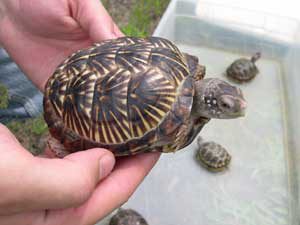
Headstarting of turtles began with egg collection from wild females or their nests. The eggs were incubated at 80° F to produce a 50/50 sex ratio*, similar to the ratio found in many wild turtle populations**. Hatchlings were captive reared for a period of 10 – 11 months. The purpose of headstarting was to grow turtles to a point where they were far less susceptible to predators. Turtles were fed an extremely protein-rich food daily to maximize their growth. This “speed growing” can also significantly reduce the time it takes to reach sexual maturity. For example, in Wisconsin, it takes 12 – 16 years for Ornate Box Turtles to mature. Maturity in reptiles is primarily achieved by reaching a certain size, and is not age-dependent. Headstarting of an Ornate Box Turtle often results in hatchlings reaching the equivalent size of 5 – 6 year olds in 10 – 11 months. This reduces the time to maturity for individuals by several years and also improves their survival chances upon release. Results of headstarting typically show a first season survival rate of over 90%; far above what experts believe is the case for first year wild-hatched turtles.
Wisconsin initiated the headstarting program experimentally in 1994 and by 1996, working with the Milwaukee County Zoo, developed a methodology that consistently produces healthy and large juvenile turtles. The headstarted turtles have been used to rebuild seven Ornate Box Turtle populations in Wisconsin, including the “mixed” population that was salvaged from our translocation work to preserve genetic diversity. The Milwaukee County Zoo, the Racine Zoo and the Henry Vilas Zoo, along with more than a dozen private citizens, raised over 1,200 ornate box turtles for release in Wisconsin. This headstarting program achieved its first milestone in 2012, reaching the final year for headstarting for four of the seven sites. Unfortunately, headstarting was terminated in 2013 by the WDNR. This has left three populations with a very uncertain future
* Most Wisconsin turtles have temperature-dependent sex determination. Average incubation temperatures above 80° F produce more females and temperatures below 80° F produce more males. Incubation temperatures above 86° F can be lethal to turtles from the upper Midwest while incubation temperatures in the low 70s or cooler often result in all male clutches with poor fitness or the embryos die prior to hatching.
**Some turtle populations have a skewed sex ratio where vehicle road mortality takes out a disproportionate number of reproductive-aged females. Female turtles often travel overland to suitable nesting sites and vehicle mortality can significantly impact populations, especially for endangered or threatened species.
Management of Dry Sand Prairies

Ornate Box Turtles face another potentially serious threat in Wisconsin. Exotic or invasive plants, such as Spotted Knapweed Centaurea stoebe, and Black Locust Robinia pseudoacacia threaten the suitability of the dry prairie habitat or its structure. Spotted Knapweed is an allelopathic plant that produces biochemical toxins in the soil that impedes competition by native species. While research has not been done to look at its direct impact on the turtles, personal observation indicates that Ornate Box Turtles purposefully avoid areas where this plant dominates, and they have not been observed to nest among this plant in Wisconsin. This invasive species spreads by seed and can quickly overtake a dry prairie if not aggressively managed to remove it or control its spread. All seven of Wisconsin’s managed Ornate Box Turtle populations are currently being threatened by this plant species. Hand pulling and the careful use of specific “sand-safe” herbicides are required to control this species.
Black Locust is a tree species native to the east-central states but that has been introduced to the northern states via plant nurseries. This species is clonal, sending out lateral shoots which produce more trees at the clone’s periphery. Clones rapidly spread, shading out the native plant species while rendering the habitat unsuitable for most of the prairie’s fauna, including Ornate Box Turtles.
These two species currently pose the greatest threat to Wisconsin’s dry prairies and the species that are dependent on this rare natural community.
To get more detail on what we have been doing annually with Ornate Box Turtles, see the Highlights Section of this website.
To learn more about invasive species, see the link for the WDNRs Bureau of Endangered Resources in the Resources Section of this website.
